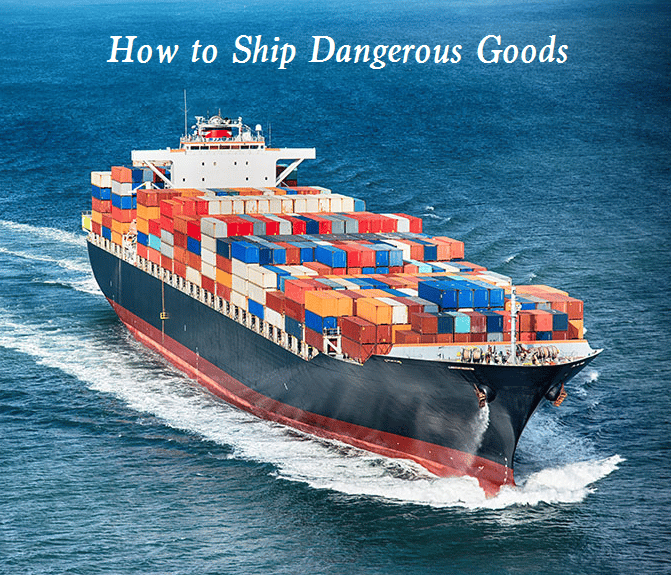In order to avoid the occurrence of safety production accidents in the transportation of dangerous goods, it is necessary to strengthen the container loading supervision and management of shipping hazardous cargo. So, what should be done when shipping dangerous goods by sea?

How to Ship Dangerous Goods – Guide to Shipping Hazardous Cargo by Sea
- After receiving the dangerous goods list, the ship must obtain the “technical specification of dangerous goods” or relevant information signed by the competent authority of dangerous goods identification from the consignor through the agent, which must include the name of dangerous goods, UN number, physical and chemical properties, first aid measures, fire fighting methods, stowage requirements and stowage precautions, loading and unloading and transportation precautions.
- The stowage plan must be reasonably stowed in accordance with the stowage isolation requirements of the international code for dangerous goods. Goods with conflicting properties or different fire fighting methods shall not be stowed in the same compartment; The stowage of inflammable and explosive dangerous goods shall have sufficient distance from all heat sources; Dangerous goods that generate harmful gas or spontaneous combustion in case of moisture shall be loaded in the cargo compartment with watertight hatch cover, water pipes in the compartment without leakage and good ventilation.
- The ship should formulate practical and feasible safety measures for the transportation of dangerous goods, including fire prevention, explosion-proof, anti-virus and other work arrangements, and emergency measures such as fire-fighting and first aid. The stowage plan and safety measures shall be explained in detail at the pre-loading meeting so that the relevant personnel can clearly understand the tasks and responsibilities, and all crew members shall be familiar with them.
- Prepare enough fresh water for fire fighting, gas masks, respirators, fire fighting equipment, first-aid drugs, protective articles, monitoring instruments, and cushion reinforcement materials as required, designate special personnel to keep them, and organize the crew to learn how to use them.
- Use high-pressure air to check and test the pyrotechnic detector, alarm, and all cabins and carbon dioxide pipeline systems to make them smooth, and check all kinds of movable fire extinguishers and fire hoses to make them in good condition.
- Check the ventilation equipment of each compartment to ensure that it is in good condition, and clean, activate, and refuel the ventilation duct sealing device, so as to ensure that carbon dioxide gas will not leak in case of carbon dioxide fire extinguishing.
- Fire prevention measures must be taken for dangerous goods during the ship. Smoking and open fire operations are strictly prohibited on the deck and in the cabin. The hatch lights shall be put in and out in time and properly arranged. The driver and crew on duty must implement various safety measures on the site, carefully supervise the loading and strictly control.
- During the loading of dangerous goods, the driver on duty should arrange for the sailors to hang or display the specified signals according to the port regulations. The master and the first mate shall not leave the ship at the same time, and sufficient personnel shall be kept on board. All personnel on duty shall carry out patrol inspections according to the regulations to enhance vigilance and prevent fire.
- In case of spilling, falling into water or other accidents during the process of loading dangerous goods, the master shall promptly report to the company and relevant competent authorities of the port and take appropriate and effective measures to properly handle them.
- The master should carefully design the route and formulate a detailed navigation plan according to the main characteristics of dangerous goods and the specific conditions and conditions of hydrology and meteorology in the sea area. In case of any difficulty, he shall immediately report to the shipping department of the company for assistance and guidance.
- No matter during navigation, anchoring, or waiting for unloading, special personnel shall be designated to regularly measure the temperature and humidity of cargo hold and cargo. Conduct closed ventilation to prevent the accumulation of sweat and combustible gas, and make records.
- The driver on duty shall regularly check the pyrotechnic detector, the second engineer and carpenter shall regularly measure the oil-water tank and sewage well, take effective measures immediately in case of any abnormality, and record it in the log book.
- Do not use the double bottom fuel oil tank of the cargo tank as far as possible. If heating is required, the master’s consent shall be obtained first, and special personnel shall be arranged to be responsible for heating until the barge moves. When there is less oil, the heating shall be paid more attention to, and it is strictly prohibited to heat the empty tank.
- Before arriving at the port, the cargo shall be opened and inspected according to the meteorological conditions and sea conditions. Sufficient ventilation must be carried out before inspection to prevent the damage of oxygen deficiency or harmful gas in the cargo held by personnel.
- The ship should be fully ventilated before unloading dangerous goods; Measures to prevent friction and spark shall be taken when opening the hatch cover. If necessary, the operation shall be carried out after passing the inspection of relevant departments. The driver on duty must check and urge the unloading workers to unload in strict accordance with the relevant operating procedures. Unsafe operation is strictly prohibited.